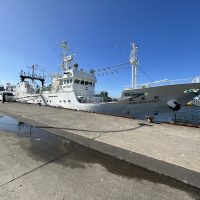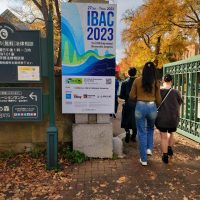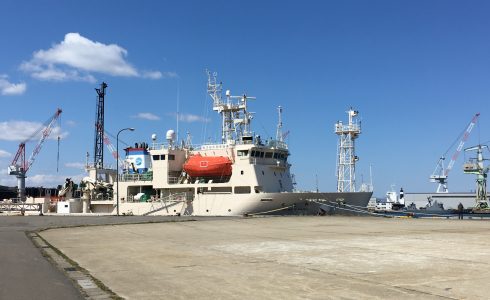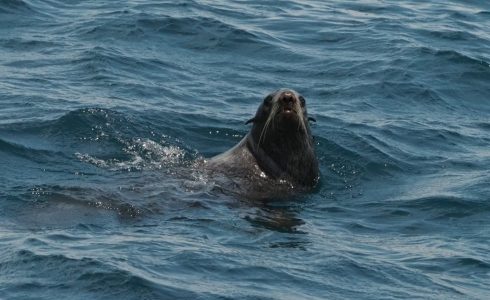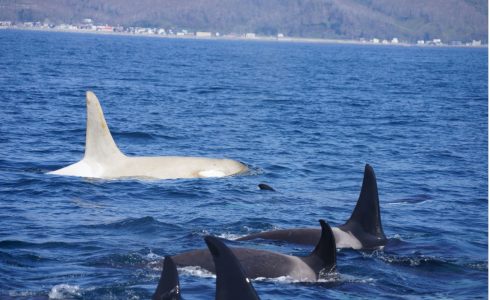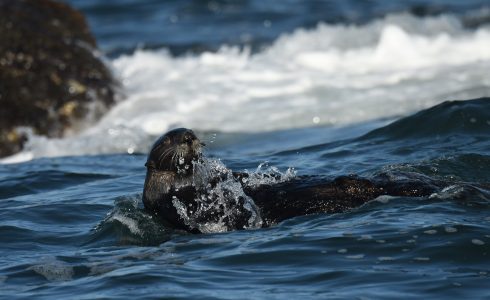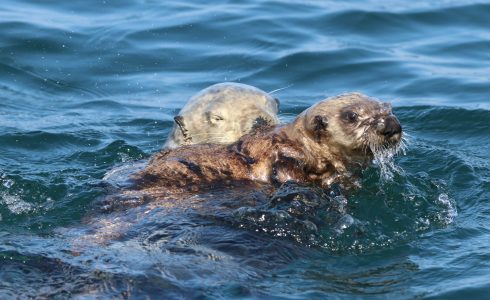D3のSさんがグリーンランドでのアザラシ調査について報告してくれました!
—
2023年8月にグリーンランドでアザラシに衛星発信器の装着をしたので,その調査報告をします.I will report on my research on satellite transmitter deployment to seals in Greenland in August 2023.
グリーンランド北西部に位置するカナック村(Qaanaaq)は人口650人程度の村落です(Fig 1).そこで暮らす人々は,海氷が融ける7月頃になると,目の前の海(Inglefield Bredning フィヨルド)で魚やアザラシ,イッカクを獲って生活をしています.しかし,近年の北極域における気温上昇によって,海氷の減少やカービング氷河(海に面した氷河)の急速な融解が進行しており,海洋生態系を大きく変化させています.このことは沿岸域で暮らす人々の生活に大きく影響すると考えられるため,今の海洋環境や海洋生態系を把握することは,環境変動の予測や地域社会への影響を評価する上で非常に重要となります.Qaanaaq is a settlement in northwestern Greenland of around 650 people (Fig 1). In open water season (the breakup of the land-fast ice from July to October), local people hunt marine mammals such as seals and narwhals. However, ongoing climate change, the loss of sea ice and thinning tidewater glaciers have already caused considerable change in Arctic marine ecosystems (Meredith et al. 2019). Because this change will impact to the life of local people, it is very important to understand the current marine environment and ecosystem for prediction of environmental change and assess the impact to the society of local communities in coastal area.
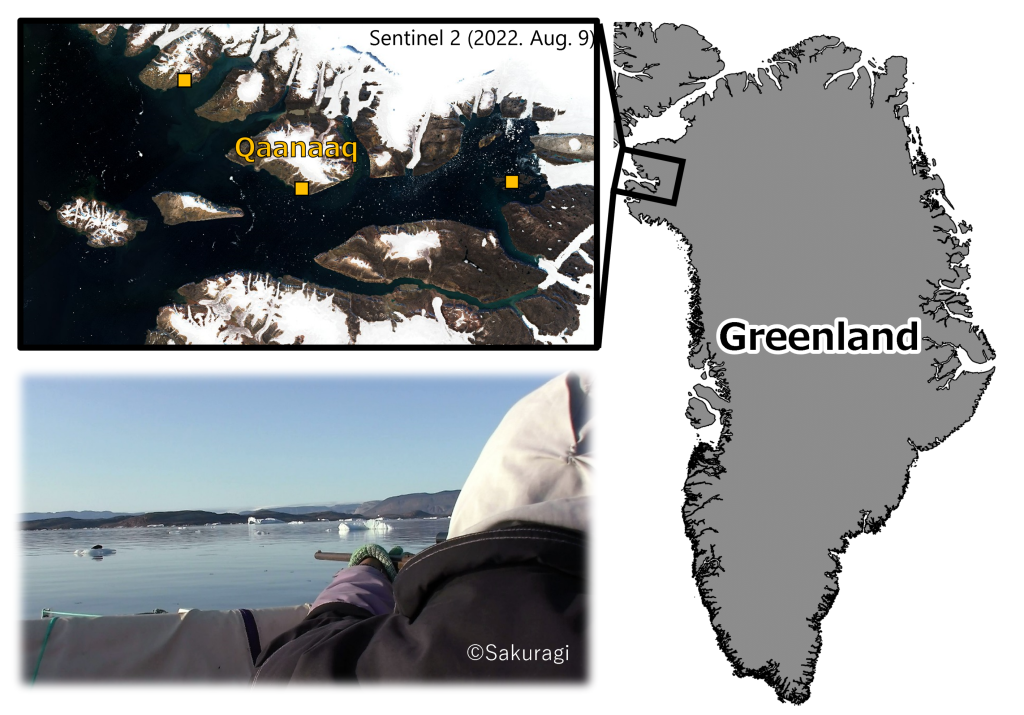
Fig 1.グリーンランドの調査地とアザラシ猟の様子.Study area in Greenland and the photo of seal hunting.
極域などの船舶による観測が難しい海域では,大型海洋動物に海洋環境を計測できる装置を取り付け,調べてもらう研究がされています(Boehme et al. 2009, Ohshima et al. 2013).7‐8月の当該海域におけるフィヨルド全体の海洋環境を調査船で調べた先行研究は存在するものの(Wills et al. 2018),時系列的な海洋観測を実施した研究例は非常に少ないです.そこで,本調査では,カナック村周辺に生息するアザラシに海洋環境を計測できる衛星発信器(CTD-SRDL: Conductivity-Temperature-Depth Satellite-Relay Data Logger,Sea Mammal Research Unit, University of St. Andrews)を装着することで,時系列的なフィヨルド内の海洋環境を調べることに挑戦しました.今回の調査では,グリーンランド天然資源研究所(Greenland Institute of Natural Resources,GINR)に所属するアザラシ研究者であるAqqalu Rosing-Asvid博士と,現地ハンター2名に協力をお願いして実施しました.Recently, animal-borne conductivity-temperature-depth (CTD) loggers have enabled researchers to conduct oceanographic surveys in the area that were difficult to conduct ship-based studies (Boehme et al. 2009, Ohshima et al. 2013). In previous study, although oceanographic surveys in this fjord were conducted (Willis et al. 2018), there are few studies that time-series oceanographic observation in front of tidewater glaciers. Therefore, in this survey, seals living around Qaanaaq region were deployed the satellite transmitter (CTD-SRDL: Conductivity-Temperature-Depth Satellite-Relay Data Logger, Sea Mammal Research Unit, University of St. Andrews) that can measure the marine environment. I conducted this survey with Aqqalu Rosing-Asvid who is a seal researcher in Greenland Institute of Natural Resources, GINR) and two local hunters.
アザラシは海底が見えるくらいの浅い場所で刺網を使って捕獲します(Fig 2).この網のメッシュ幅は大きく(18 cm),上部は海面に浮かぶため,アザラシが網に絡まっても呼吸ができるようになっています.このような刺網をアザラシがいそうな海域に複数設置して,キャンプをしながら待ちました.The drift gill nets in areas shallow enough to see the seafloor to capture seals (Fig. 2). The mesh of the nets is relatively large for seals (the mesh width = 18 cm), and the upper part floats on the surface of the sea, allowing seals to breathe even if they are entangled in the net. We set up these modified drift gill nets in several areas where seals were likely to be and waited while camping.
刺網で捕まえられるのはアザラシだけではなく,海藻や氷山の欠片も掛かってしまいます(Fig 2).これらをそのまま放置しておくと,網目が見えやすくなってアザラシが捕まりにくくなったり,網が切れたり,流されてしまうこともあります.なので,数時間おきに刺網を確認し,丁寧に海藻や氷を取り除きました.The drift gill nets caught not only seals, but also seaweeds and ice pieces (Fig. 2). If these are left in the gill net, they can easily become visible, making it difficult to catch seals, and the net can break or be swept away. Therefore, we checked the gill nets every few hours and carefully removed seaweeds and ice pieces.
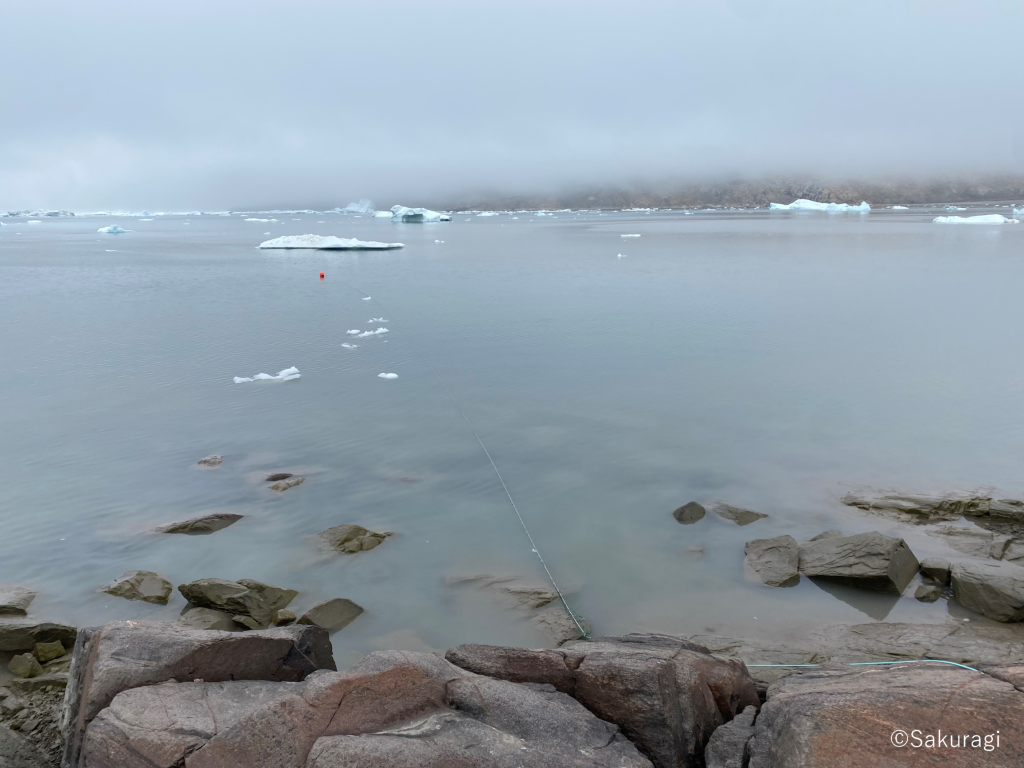
Fig 2.沿岸の大きな岩に刺網の端を括り付け,岸から海に向けて90 m(または45 m)の特製の刺網を出します.The end of the gill net is strapped to a large rock on the shore, and a modified drift gill net 90 m (or 45 m) out to sea from the shore.
網にアザラシがかかることを確認できたら,棒2本に網のついた道具で,アザラシをすくい上げ(Fig 3a),その網をナイフで丁寧に取り除きました.今回捕まえることのできたのはワモンアザラシで,網に入ってしまえばとても大人しくなります(Fig 3b).After a live seal was found in the gill net, we scooped it up with a tool consisting of two sticks with a net (Fig 3a), and carefully removed the net of the gill net with a knife. This time, we caught ringed seals. They were very calm in the net (Fig 3b).
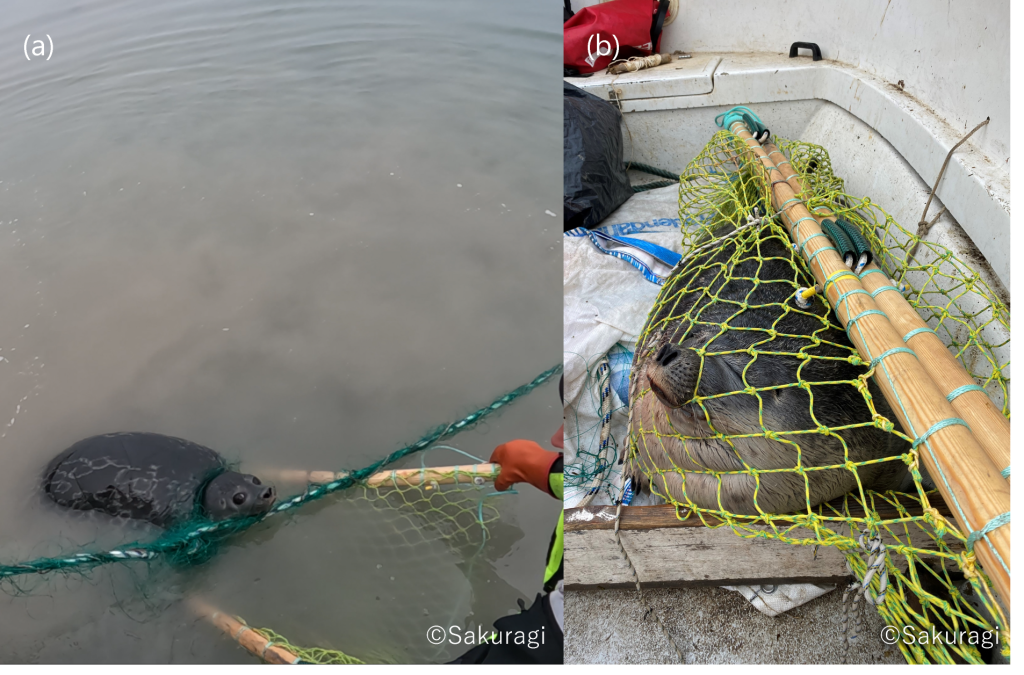
Fig 3. 刺網にかかったアザラシを捕まえている様子(a)と大人しくなったワモンアザラシ(b).Catching a seal entangled in the gill net (a), and a calmed ringed seal (b).
その後,頑張って岸まで運び,計測とサンプリング,そして発信器の装着をしました.発信器は瞬間接着剤でアザラシの毛皮に取り付けられ,バッテリーが切れるか,翌年の換毛などによって脱落するなどするまで発信し続けます.発信器装着後,丁寧に網を外し,アザラシをリリースしました(Fig 4).最終的に,7日間のキャンプ生活で,4頭のアザラシを捕獲し,3頭のアザラシに衛星発信器を装着することができました(1頭は小型だったため,発信器装着はしませんでした).The seals were then brought to shore, measured, check sex, sampled, and deployed a transmitter. The transmitter was attached to the seal’s back fur with instant adhesive, and transmission will continue until the battery ran out or fall out due to molting. After attaching the transmitter, the net was carefully removed, and the seal was released (Fig 4). In the end of the survey, we were able to capture four seals and deployed CTD-SRDLs to three of them (one seal was too small for deployment) during the seven days at the camp.

Fig 4.発信器を装着したワモンアザラシ.A ringed seal with a CTD-SRDL.
村に戻り,無事に発信器3つからデータが発信されていることを確認できて,とても安心しました.これから,たくさんのデータを送ってもらうことを祈っています!I was very relieved when I returned to Qaanaaq and confirmed that the three tags were transmitted data safely. I hope they will send me a lot of data in the future!
最後に,Aqqaluさんには発信器装着の全面的な協力をしていただきました.また,現地ハンターのお二人に加え,カナック村の拠点で生活した北海道大学の先生方,学生方のみなさん,日本でサポートしてくださった皆さんと,非常に多くの方々の協力の上で調査を成功することができたと思います.また,本調査は,ArCSIIの予算で行われました.この場をお借りして,感謝申し上げます.ありがとうございました.Finally, I would like to thank Aqqalu for his full cooperation with the deployment of the transmitters. In addition to the local hunters. I would like to thank the Hokkaido University professors and students who lived with in Qaanaaq, as well as everyone who supported me in Japan. I believe that the survey was a success thanks to the cooperation of a great many people. This survey was financially supported by the Arctic Challenge for Sustainability II (ArCSII) project. Thank you very much!
References
Boehme, L., P. Lovell, M. Biuw, F. Roquet, J. Nicholson, S. E. Thorpe, M. P. Meredith, and M. Fedak. 2009. Technical note: Animal-borne CTD-Satellite Relay Data Loggers for real-time oceanographic data collection. Ocean Sci. 5: 685–695. doi:10.5194/os-5-685-2009
Meredith, M., Sommerkorn, M., Cassotta, S., Derksen, C., Ekaykin, A., Hollowed, A., Kofinas, G., Mackintosh, A., Melbourne-Thomas, J., Muelbert, M. M. C., Ottersen, G., Pritchard, H., & Schuur, E. A. G. (2019). Polar regions. In H.-O. Pörtner, D. C. Roberts, V. MassonDelmotte, P. Zhai, M. Tignor, E. Poloczanska, & N. M. Weyer (Eds.), IPCC special report on the ocean and cryosphere in a changing climate. In press. Cambridge University Press, Cambridge, UK, and New York, NY, USA.
Ohshima, K. I., and others. 2013. Antarctic bottom water production by intense sea-ice formation in the Cape Darnley polynya. Nat. Geosci. 6: 235–240. doi:10.1038/NGEO1738
Willis, J.K., D. Carroll, I. Fenty, G. Kohli, A. Khazendar, M. Rutherford, N. Trenholm, and M. Morlighem. 2018. Ocean-ice interactions in Inglefield Gulf: Early results from NASA’s Oceans Melting Greenland mission. Oceanography 3. doi: 10.5670/oceanog.2018.211.
Links
・北極域研究加速プロジェクト(ArCS II): https://www.nipr.ac.jp/arcs2/
・グリーンランド天然資源研究所(Greenland Institute of Natural Resources):https://natur.gl/


